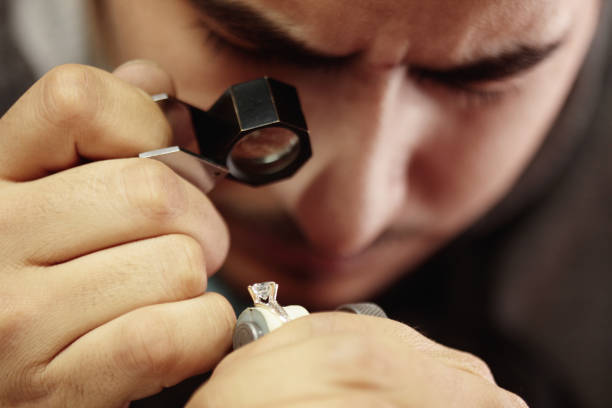
The word 'type' is somewhat ambiguous in most contexts. However, in the case of diamonds, the term refers to a very specific classification system that examines these dazzling gemstones on a molecular level. So put on your scientist hats and continue reading for a comprehensive guide to the various types of diamonds, why you should care about them, and how to make an informed future purchase.
The presence or absence of atoms other than carbon in the crystal lattice mentioned above is the simplest way to think about diamond type classification on a molecular level. It is also necessary for distinguishing natural, treated, and laboratory-grown diamonds. Although diamonds are essentially pure carbon, most contain trace amounts of nitrogen and are classified as Type I, while diamonds with no detectable nitrogen are classified as Type II. Type I and Type II each have two additional separations.
Gemologists use infrared spectroscopy, a standard scientific technique, to differentiate between these different types of diamonds. Jewelers can also use diamond testing instruments to distinguish between Type I and Type II diamonds, such as the GIA iD100 gem screening device.
In nature, type Ia is the most common. The nitrogen atoms in this crystal lattice are arranged in pairs or as single nitrogen atoms paired with a vacancy—a missing carbon atom in the crystal lattice. Nitrogen atoms in Type Ib are isolated in the sense that each single nitrogen atom has adjacent carbon atoms.
Sub-grades in Type II are less complex. Type IIa has a simple crystal lattice of adjoined carbon atoms with no detectable nitrogen or other elements, whereas Type IIb contains boron atoms, which can often result in a blue color.
When purchasing a diamond, you will most likely come across some terminology that you are unfamiliar with—this isn't a big deal. While it is not necessary to know everything ahead of time, there are a few concepts and terms to review. To begin, gemologists describe diamonds using the 4Cs and the GIA grading system nomenclature. Learn the definitions of fluorescence, diamond treatments, origin, and laboratory-grown diamonds.
Fluorescence refers to how diamonds react to ultraviolet light, diamond treatments are enhancements that improve a diamond's color or clarity, origin refers to where a diamond comes from, and laboratory-grown diamonds...are grown in a laboratory or factory over a period of days or weeks.
Beyond the Type I and Type II classifications, there are a few notable consumer-facing diamond types on the market that do not necessitate a degree in gemology to fully comprehend, one of which is shape. The majority of diamonds are round; the remainder are fancy-shaped, which means any shape other than round. Princess, oval, cushion, emerald, marquise, and heart are examples of fancy shapes. These shapes are determined by the diamond cutter and polisher, who are frequently influenced by the shape and condition of the original mined rough diamond.
Another important distinction that has already been made is between natural and laboratory-grown plants. Natural diamonds, as you may know, form deep within the earth under extreme conditions such as high temperature and pressure. Diamonds formed millions, if not billions, of years ago and reached the earth's surface through volcanic activity.
Laboratory-grown diamonds, on the other hand, are grown in a laboratory or factory over a period of days or weeks. Natural diamonds and laboratory-grown diamonds have essentially the same chemical, physical, and optical properties, and the two cannot be distinguished with the naked eye. However, due to the vastly different conditions under which they form, GIA experts using specialized instrumentation can distinguish them with absolute certainty.
Fancy-colored diamonds are another type of diamond mentioned by Pesqueira. Any natural diamond with a color—often yellow or brown, but also blue, red, green, and others outside the GIA D-to-Z color-grading scale. These vibrant colors are caused by trace elements or the geological conditions under which the crystal formed. Fancy blue color, for example, is caused by the presence of boron, and fancy green color is caused by exposure to a specific type of radiation.
Rarity, like most other categories, often translates to higher value. As a result, Type IIa natural diamonds (which are considered extremely rare) will command a premium. It is important to note that the majority of natural diamonds are Type I, with traces of nitrogen. However, colorless to near-colorless lab-grown diamonds are Type IIa with no traces of nitrogen. As you can see, being able to distinguish between a Type IIa natural diamond and a Type IIa lab-grown diamond is critical because one accounts for approximately one to two percent of all natural diamonds while the other can be grown in a laboratory.
Diamond types, in general, have no effect on the appearance of the gemstone, so unless you're a rare gem collector, this may not be the most important quality in a diamond when looking for your own (whereas something like the 4Cs will play a bigger part in the decision process). The most important decision you'll have to make is between a natural diamond and a lab-grown diamond—a choice that has advantages and disadvantages on both sides and is entirely up to you.
Sell your diamonds with ease with Diamond Registry’s comprehensive approach and vast global industry connections to help you find the best buyer for your diamond fast. Visit www.diamondregistry.com/sell-your-ring to take your first step to fast, easy and reliable way of selling your diamond.
Want to check and calculate diamond per carat instantly? Go to DR’s diamond price calculator to know how. Reliable and trusted carat calculator in the diamond industry since!

